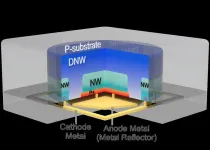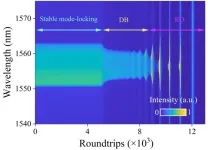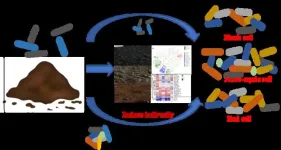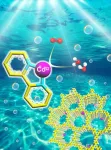(Press-News.org) Palliative care is the interdisciplinary medical specialty of caring for people with serious and often terminal illnesses. Its aim is to improve quality of life for such patients and their families, by relieving symptoms and stress. Palliative care is widely considered to be a human right, even if the World Health Organization estimates that only 14% of the approximately 56.8 million people who need it each year worldwide actually receive it. Since seriously ill patients often experience stress, psychological interventions such as relaxation therapy play an important role in palliative care.
Now, researchers have shown in a ground-breaking clinical trial that a novel intervention, Flourishing-Life-of-Wish Virtual Reality Relaxation Therapy (FLOW-VRT-Relaxation), helps cancer patients in palliative care hospices to manage their symptoms and stress better, and may even help them to achieve a last wish. Their results are published in Frontiers in Virtual Reality.
“Here we show that relaxation assisted by virtual reality (VR) outperforms traditional relaxation therapy in terms of physical and psychological symptom management in palliative care,” said lead author Olive Woo, a doctoral student at the Department of Psychology of the University of Hong Kong, and a registered clinical psychologist and certified thanatologist.
Virtual reality to induce ‘flourishing’
FLOW-VRT-Relaxation, designed by Woo and team in 2020, combines standard-of-care relaxation therapy – teaching patients diaphragmatic breathing, to slow their heartbeat, lower blood pressure, and reduce stress – with watching a relaxing 360° panoramic video played on an immersive VR headset. It aims to promote the psychological state of 'flourishing': optimal well-being and fulfillment, where patients experience positive emotions, engage in meaningful activities, and have a sense of purpose and accomplishment.
Between November 2022 and September 2023, the researchers recruited 128 volunteers among adult female and male patients with terminal cancer in the palliative care ward of a public hospital in Hong Kong. Half of the volunteers were randomly assigned to each of two groups: either FLOW-VRT-Relaxation, including coaching in diaphragmatic breathing by Woo, in the intervention group, or such standard-of-care coaching only in the control group.
The eight VR videos had been preselected (based on responses to a survey among eligible patients) as likely to give patients a sense of joy, closure, and a meaningful end-of-life experience. They may even help them to achieve a last wish, for example seeing the cherry blossoms in Japan, even if just in VR. Each video was 10 minutes long, and accompanied by soothing music. Similar music was also played for patients in the control group. Each participant in the intervention group chose his or her preferred video from the shortlist.
Spontaneous feedback from patients was positive: “Some participants expressed a sense of awe and wonder as they immerse themselves in virtual environments and engaged in activities they previously thought impossible. Others expressed feelings of joy, excitement, and gratitude for being able to fulfill their wishes or engage in activities they have always dreamed of, or a sense of empowerment and confidence through their engagement with VR technology,” observed Woo.
Physical and emotional benefits
The effectiveness of both treatment groups in promoting well-being was rated with the Cantonese version of the Edmonton Symptom Assessment System (CESAS): a questionnaire with known clinical validity that measures nine common symptoms of patients with cancer, such as pain, depression, and anxiety. A lower CESAS score means greater physical and emotional well-being.
CESAS scores dropped after treatment in both groups, but this improvement was significantly greater in the intervention group. For example, the score on the subscale for physical symptoms fell by 4.1 points (26.6%) in the FLOW-VRT-Relaxation group, compared to 2.1 points (13.0%) in the control arm, while the score on the subscale for emotional symptoms by 2.25 points (47.4%) in the FLOW-VRT-Relaxation arm, compared to 1.0 points (19.6%) in the control group.
The authors conclude that FLOW-VRT-Relaxation is an effective, inexpensive, scalable, and personalized therapy for patients in palliative care, at least in the short term.
“We believe that the VR experiences activate psychological mechanisms that promote self-determination, flow experience, and restoration, ultimately improving the physical and emotional well-being of patients in palliative care more than does relaxation therapy alone,” said co-author Dr Antoinette Lee, a health psychologist at the same institute as Woo and her academic supervisor.
Further research planned
The researchers plan to follow up the present study by studying the longer-term effects of FLOW-VRT-Relaxation on patients’ well-being.
“Our present study was the first of its kind to rigorously test the efficacy of VR-assisted relaxation among patients under palliative care in a randomized controlled trial with an adequate sample size,” said co-author Dr Alvaro Cassinelli, an associate professor with expertise in augmented and virtual reality.
“We look forward to investigating further the advancement of personalized virtual reality and augmented reality environments currently explored in the framework of doctoral work by co-authors Royce Ng and Daniel Eckhoff.”
END
Virtual reality treatment for palliative care shown to help patients ‘flourish’ during relaxation therapy
Clinical trial shows greater benefits of novel relaxation therapy involving virtual reality for patients with cancer
2024-01-31
ELSE PRESS RELEASES FROM THIS DATE:
Antiviral color nanocoating technology
2024-01-31
Since the onset of COVID-19, we've become accustomed to seeing antiviral films attached to elevator buttons and public transportation handles. However, conventional antiviral films are made by mixing antiviral metal particles with polymers. Due to the manufacturing process, only a very small fraction of these metal particles is exposed on the surface. As a result, contrary to the belief that these films will protect us from viruses, the actual antiviral effect upon contact with the film surface is not ...
Key LiDAR sensor elements for autonomous vehicles are now made with our technology
2024-01-31
LiDAR sensors are indispensable for the realization of advanced technologies such as advanced driver assistance systems (ADAS), autonomous driving, and AR/VR. In particular, short- and mid-range LiDAR used in AR/VR devices and smartphones requires better distance (depth) resolution to detect the shape of a person or object more accurately, and so a single-photon detector with better timing jitter performance is required.
LiDAR measures distance and creates a 3D image by calculating the time it takes for a photon emitted by the transmitter to strike an object, reflect, and arrive back at the ...
Dissipative soliton vanishes, breathing dynamics occur
2024-01-31
Solitons are quasiparticles that propagate along a non-dissipative wave. Put another way, they are waveforms that hold their shape as they move—like a single wave moving across the surface of a pond. They can also show the particle-like behavior, such as collision, attraction, and repulsion. Ultrafast fiber laser is an ideal platform to explore nonlinear dissipation dynamics, but also deepen the understanding of optical soliton properties. In dissipative system, dissipative soliton can be obtained due to the balance between nonlinearity and ...
American Heart Month 2024 brings renewed focus on CPR, urgent need for Nation of Lifesavers™
2024-01-31
DALLAS, Jan. 30, 2024 — A new survey conducted by the American Heart Association, which is marking one hundred years of service saving lives, suggests that increased visibility of the need for CPR has had a positive impact on someone’s willingness to respond if they are bystanders in a cardiac emergency. However, there remains a significant gap in awareness that emphasizes the urgent need for collaboration between governments, communities, businesses and the media to promote and provide lifesaving training. To help close this gap, the ...
Fluvo-aquic soil treated with pig manure present a higher risk of antibiotic-resistant bacteria than black and red soils
2024-01-31
In agroecosystems where manure is applied as organic fertilizer, these antibiotic residues exert strong selective pressure on soil microbial communities. Antibiotic-resistant bacteria (ARB) from animal manure would increase the concentration of ARB in soils. The influencing mechanisms of soil types on the distribution of ARB were worthy of further exploration. This study demonstrates that CTC-manure induced more resistance of soil indigenous microbes in fluvo-aquic soil, Lactobacillus, Dyella, Ralstonia, and Bacillus ...
Black summer bushfires in Australia wiped $2.8 billion from tourism supply chain
2024-01-31
A first of its kind study of the 2019-2020 ‘Black Summer’ bushfires in Australia has revealed that the tourism industry nationwide took an immediate hit of $2.8 billion in total output to its broader supply chains and almost 7300 jobs disappeared nationwide.
The fires four years ago triggered widespread tourism shutdowns in many parts of the country in the lead up to the peak Christmas and New Year season, resulting in $1.7 billion direct losses to the tourism industry, which triggered the larger drop in supply chain output.
“These results are an illustration of what can be expected in the future not only in Australia, but in other ...
Using computers to design proteins allows researchers to make tunable hydrogels that can form both inside and outside of cells
2024-01-31
When researchers want to study how COVID makes us sick, or what diseases such as Alzheimer's do to the body, one approach is to look at what's happening inside individual cells.
Researchers sometimes grow the cells in a 3D scaffold called a "hydrogel." This network of proteins or molecules mimics the environment the cells would live in inside the body.
New research led by the University of Washington demonstrates a new class of hydrogels that can form not just outside cells, but also inside of them. The team created these hydrogels from protein building blocks designed using a computer to form a specific structure. These hydrogels exhibited similar mechanical properties ...
BIPOC individuals bear greater post-COVID burdens
2024-01-31
A study study published today reports that BIPOC individuals who were infected with COVID-19 experienced greater negative aftereffects in health and work loss than did similarly infected white participants.
Despite similar symptom prevalence, Hispanic participants compared to non-Hispanic participants and BIPOC participants compared to white participants had more negative impacts following a COVID-19 infection in terms of health status, activity level and missed work, the authors wrote.
The findings appeared in the journal Frontiers ...
Anchoring single Co sites on bipyridine-based CTF for photocatalytic oxygen evolution
2024-01-31
Photocatalytic water splitting using semiconductors is regarded as a promising technique for producing hydrogen fuel from solar energy. The oxygen evolution half reaction has proven to be the bottleneck for photocatalytic overall water splitting owing to the high energy barrier and the sluggish kinetics. It is a big challenge to develop efficient photocatalysts for the advancement of water oxidation.
Similar to graphene carbon nitride, π-stacked covalent triazine frameworks (CTFs) have gained much attention in photocatalytic water splitting in recent years. The fully conjugated structure with the regular channels in the crystalline network will provide defined pathways for ...
AI-powered app can detect poison ivy
2024-01-31
Poison ivy ranks among the most medically problematic plants. Up to 50 million people worldwide suffer annually from rashes caused by contact with the plant, a climbing, woody vine native to the United States, Canada, Mexico, Bermuda, the Western Bahamas and several areas in Asia.
It’s found on farms, in woods, landscapes, fields, hiking trails and other open spaces. So, if you go to those places, you’re susceptible to irritation caused by poison ivy, which can lead to reactions that require medical attention. Worse, most people don’t know ...
LAST 30 PRESS RELEASES:
Statins significantly reduce mortality risk for adults with diabetes, regardless of cardiovascular risk
Brain immune cells may drive more damage in females than males with Alzheimer’s
Evidence-based recommendations empower clinicians to manage epilepsy in pregnancy
Fungus turns bark beetles’ defenses against them
There are new antivirals being tested for herpesviruses. Scientists now know how they work
CDI scientist, colleagues author review of global burden of fungus Candida auris
How does stroke influence speech comprehension?
B cells transiently unlock their plasticity, risking lymphoma development
Advanced AI dodel predicts spoken language outcomes in deaf children after cochlear implants
Multimodal imaging-based cerebral blood flow prediction model development in simulated microgravity
Accelerated streaming subgraph matching framework is faster, more robust, and scalable
Gestational diabetes rose every year in the US since 2016
OHSU researchers find breast cancer drug boosts leukemia treatment
Fear and medical misinformation regarding risk of progression or recurrence among patients with breast cancer
Glucagonlike peptide-1 receptor agonists and asthma risk in adolescents with obesity
Reviving dormant immunity: Millimeter waves reprogram the immunosuppressive microenvironment to potentiate immunotherapy without obvious side effects
Safety decision-making for autonomous vehicles integrating passenger physiological states by fNIRS
Fires could emit more air pollution than previously estimated
A new way to map how cells choose their fate
Numbers in our sights affect how we perceive space
SIMJ announces global collaborative book project in commemoration of its 75th anniversary
Air pollution exposure and birth weight
Obstructive sleep apnea risk and mental health conditions among older adults
How talking slows eye movements behind the wheel
The Ceramic Society of Japan’s Oxoate Ceramics Research Association launches new international book project
Heart-brain connection: international study reveals the role of the vagus nerve in keeping the heart young
Researchers identify Rb1 as a predictive biomarker for a new therapeutic strategy in some breast cancers
Survey reveals ethical gaps slowing AI adoption in pediatric surgery
Stimulant ADHD medications work differently than thought
AI overestimates how smart people are, according to HSE economists
[Press-News.org] Virtual reality treatment for palliative care shown to help patients ‘flourish’ during relaxation therapyClinical trial shows greater benefits of novel relaxation therapy involving virtual reality for patients with cancer






